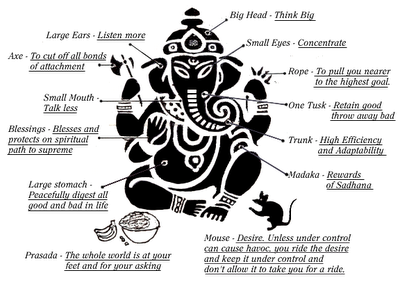Ganapati or Ganesha is the Hindu God, who is the most popular among the Hindu dieties.
He is believed to remove obstacles, and is invoked at the commencement of any endeavor.
Be it starting a journey, building a house, or any other auspicious venture, Hindus pray to Ganesha at the outset of starting anything.
He is known to be the god of wisdom who wrote the Hindu epic, Mahabharata, as Sage Vyasa narrated it. He is the lord for knowledge and divine stature.
The seeds of the concept of Ganesha were first sowed during the ancient days of Rigveda. This passed through epics and the Puranas to bring about the current form of Ganapati or Ganesha that we know today.
Origin
The birth of Lord Ganesh is one of the fascinating stories in Hindu mythology. There are several legends that surround the birth of Ganesha. Ganesha is the son of Shiva and Parvati.
Ganesha was created was an idol by Parvati using the dirt of her body. Since, the idol had components of Parvati’s body, she accepted him as her son.
One day, Parvati asked little Ganesha to be a guard at the door, while she took a bath. Shiva wanted to enter the abode with his followers and little Ganesh refused to let him in.
Shiva, who was not familiar with his son, was enraged by the hindrance and ordered his followers to attack the little boy. The boy’s head was chopped off in the fight that ensued.
Parvati was aghast with grief on learning the accident and demanded Shiva to restore the boy to life. Shiva, thus, ordered his followers to find a mom who sleeps with her newborn baby. The head of such a baby would be attached to the boy’s body.
The followers first found the head of an elephant calf with white tusks. Thus, the re-birth of Ganesha took place with the head of an elephant. Shiva blessed the boy that Ganesha would be worshipped by people before undertaking any task.
Appearance
The most popular and accepted form of Ganapati is the red-colored human body with an elephant’s head. He has two large ears similar to a winnowing basket and two tusks one of which is broken.
A large belly which is decorated with a snake belt adorns his body. He also wears the sacred thread across his chest. He usually is seated in the lotus pose or the padmasana posture.
Interpretation
Every little peculiarity of Ganesha has a deep spiritual significance. Here is the meaning of this symbolic representation of Lord Ganesha.

Vehicle
Karaucha, a Gandharva was strolling in the court of Indra, when he accidentally stepped on sage Vamadeva. The enraged sage turned him into a mouse and cursed that he will remain so until Ganesha made him as his vehicle.The mouse thus was in the hermitage of Sage Parashara, when Ganesha visited the place.
The mouse instantly recognized him and offered prayers to him. Ganapati pleased with his prayers wanted to grant the mouse a boon. The mouse expressed his desire to become his vehicle,which was granted. Thus, Ganapati is always accompanied by Mooshakavahana or the mouse.
Other legends mention that the mouse was a gift to Ganesh from the earth on his birthday.
Marriage
Shiva and Parvati, pleased with Ganesha’s affection and love, arranged his marriage with two daughters of Prajapati – Siddhi and Budddhi. It is said that he got two sons – Kshema and Labha from Siddhi and Buddhi, respectively.
Yet another legend mentions that Siddhi and Buddhi, daughters of Brahma worshipped Ganesha whole heartedly, that he accepted them as his wives.






